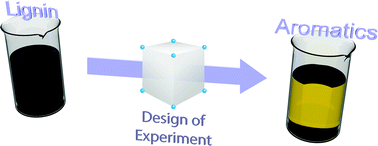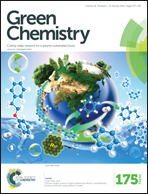Overcoming lignin heterogeneity: reliably characterizing the cleavage of technical lignin†
Abstract
The cleaving of technical lignin by different technologies is a promising but complex approach for the production of value-added compounds from biomass. A rigorous description of the underlying mechanisms and influencing parameters is complicated by lignin's heterogeneity, hampering comparability and reproducibility. This frequently leads to contradicting data and theories in the scientific community. By applying a statistical design of experiment approach to the electro-oxidation of Kraft lignin, the statistical variation of the experimental data can be separated from the systematic effects of reaction parameters on lignin properties. The data allow a clear quantification of the effect of temperature, alkalinity, catalyst, lignin concentration and current density on the molecular weight, monomer production, UV absorbance as well as acid-solubility of the treated lignin. The method described can be applied to reliably investigate the whole range of lignin cleavage technologies in spite of the pronounced heterogeneity of lignin.


 Please wait while we load your content...
Please wait while we load your content...